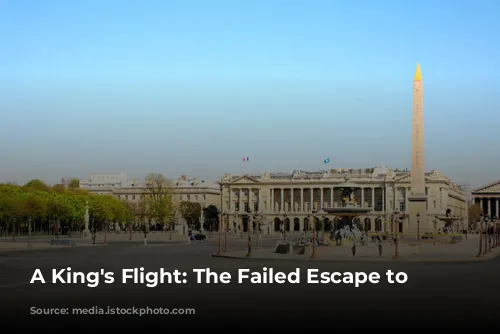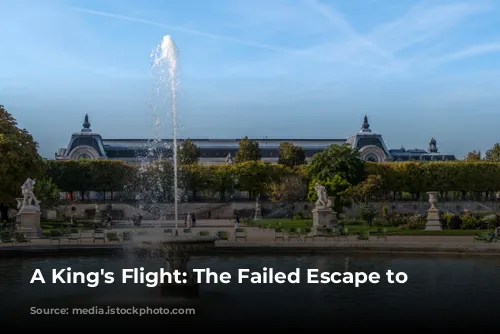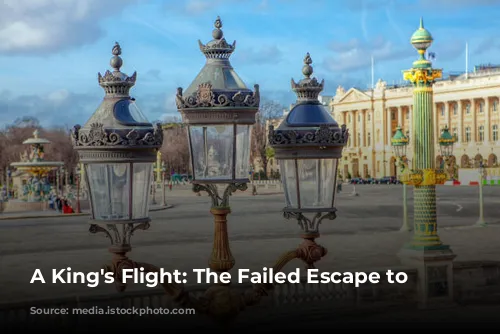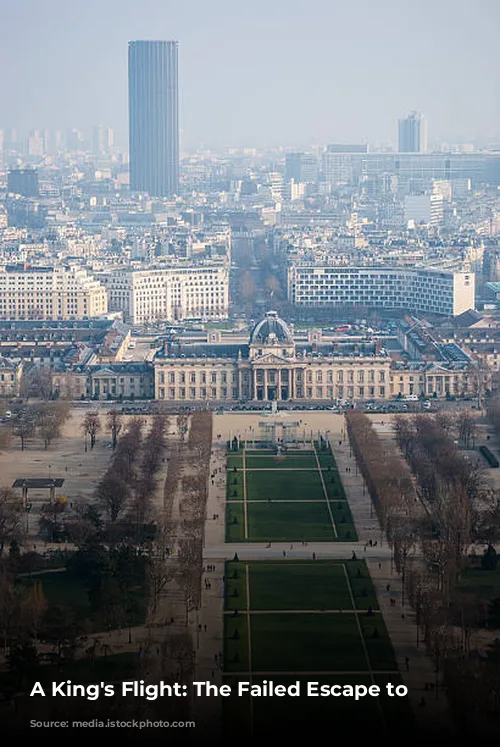The French Revolution was a time of great upheaval and change. In the spring of 1791, King Louis XVI and his family had been effectively imprisoned in the Tuileries Palace for over a year and a half. Appalled by the growing radicalism of the revolution, especially the anti-clerical sentiments, the king decided to escape Paris.

A Desperate Plan
Louis’ escape plan, devised by Count Axel von Fersen, a Swedish aristocrat and close confidante of Queen Marie Antoinette, involved traveling by carriage to Montmedy, a fortress near the German border garrisoned by royalist troops. Despite several missteps, the royal entourage reached within 30 kilometers of their destination before the king was recognized by a local postmaster. Louis and his family were immediately captured and escorted back to Paris. This failed escape, known as the Flight to Varennes, marked a turning point in the revolution. The king’s attempted flight shattered any remaining hope of a constitutional monarchy. He could no longer be trusted, and his previous agreements with the National Constituent Assembly were viewed as deceptive.
The Road to Rebellion
Several factors contributed to Louis’ decision to flee Paris. One was the influence of Honoré Mirabeau, a powerful politician who had initially appeared to be a revolutionary but held deeply conservative views. He believed in a strong monarchy with limited power checked by a constitution and a legislative assembly. He feared that if the monarchy fell, France would descend into chaos and anarchy.
Mirabeau became a secret advisor to the king, working behind the scenes to strengthen the monarchy. In May 1790, he signed a secret agreement with the crown, promising to support the king’s interests in the National Constituent Assembly. His notes to the king, discovered after his death in 1791, revealed the extent of his actions.
Louis was also deeply troubled by the Civil Constitution of the Clergy, a law passed by the Assembly in 1790 that significantly altered the role of the Catholic Church in France. The king, a devout Catholic, refused to accept the Constitution and privately boycotted any Mass conducted by a priest who had sworn allegiance to it.
In April 1791, the king’s refusal to attend a public Easter Mass at the Louvre, which would have required him to receive communion from a constitutional priest, led to a minor controversy and further fueled rumors of his discontent with the revolution.

Fersen’s Scheme: A Delicate Escape
Count Fersen, a Swedish military leader and diplomat, was deeply involved in the king’s escape plan. He was a frequent visitor to France and a close friend of Queen Marie Antoinette. Although some speculate that Fersen and the queen were lovers, this is difficult to prove.
Fersen, supported by King Gustav III of Sweden, who was eager to see the French royal family safe, developed a complex escape route. The plan involved leaving the Tuileries through unguarded doors, changing clothes, using false passports, relying on bodyguards, traveling through the backstreets of Paris, and exchanging carriages on the city’s outskirts. This intricate plan aimed to transport the king and his family to Montmedy, a fortress in northeastern France, where loyal soldiers awaited their arrival. The journey was expected to take an entire day, covering a distance of around 325 kilometers.

A Chain of Mishaps
The escape was set in motion on the evening of June 20th. However, a series of unfortunate events and delays hampered the plan. The king’s departure was delayed by a visit from Marquis de Lafayette and Jean-Sylvain Bailly, two key figures in the revolution. Marie Antoinette, leaving the Tuileries as planned, became lost in the streets before finding her carriage. The royal entourage was further delayed by a wedding party and a carriage accident near Châlons. By dawn on June 21st, they were significantly behind schedule.

The King’s Capture: A Turning Point
News of the king’s escape reached Paris as his carriage passed through Châlons. A National Guard unit was immediately dispatched to apprehend the fleeing royals. The escape sparked widespread anger and suspicion in Paris. Some accused high-ranking officials of aiding the king’s escape.
As the king’s carriage reached Sainte-Menehould, about 80 kilometers from Montmedy, a local postmaster, Jean-Baptiste Drouet, recognized the king from a coin or assignat. While allowing the royal party to continue, Drouet alerted authorities, leading to their capture in Varennes, 50 kilometers from their intended destination.
Louis was arrested on June 21st and escorted back to Paris the next morning. A contingent of Royalist troops arrived at Varennes as the king’s carriage was about to depart, hoping to rescue him. However, fearing a violent confrontation and potential bloodshed, the Royalist officers decided against an attack.
The king’s unsuccessful attempt to escape Paris, known as the Flight to Varennes, significantly escalated tensions within the revolution. It marked the beginning of a new era of suspicion and distrust toward the monarchy. Louis XVI’s actions effectively sealed his fate, paving the way for the dramatic events that would follow.








